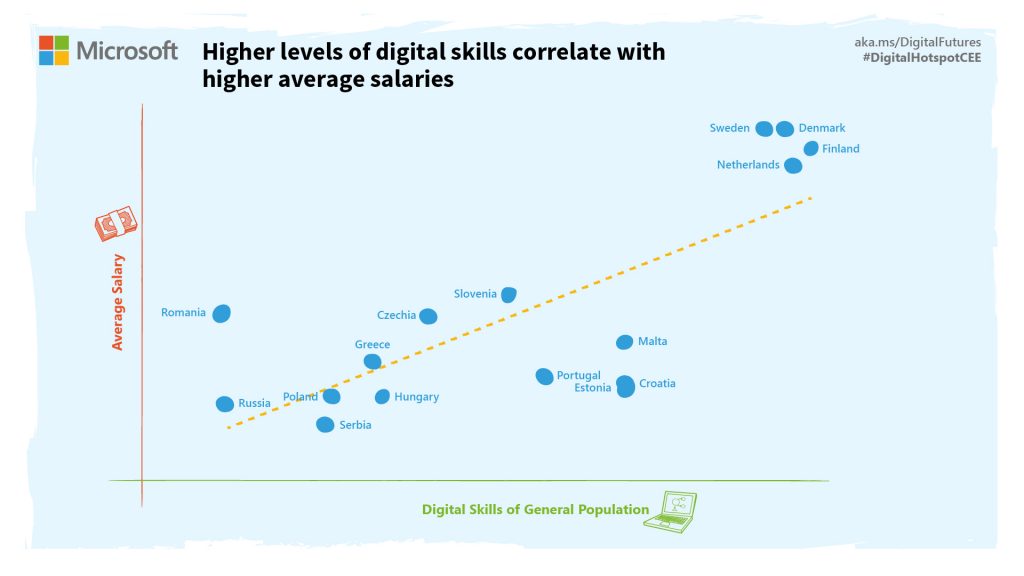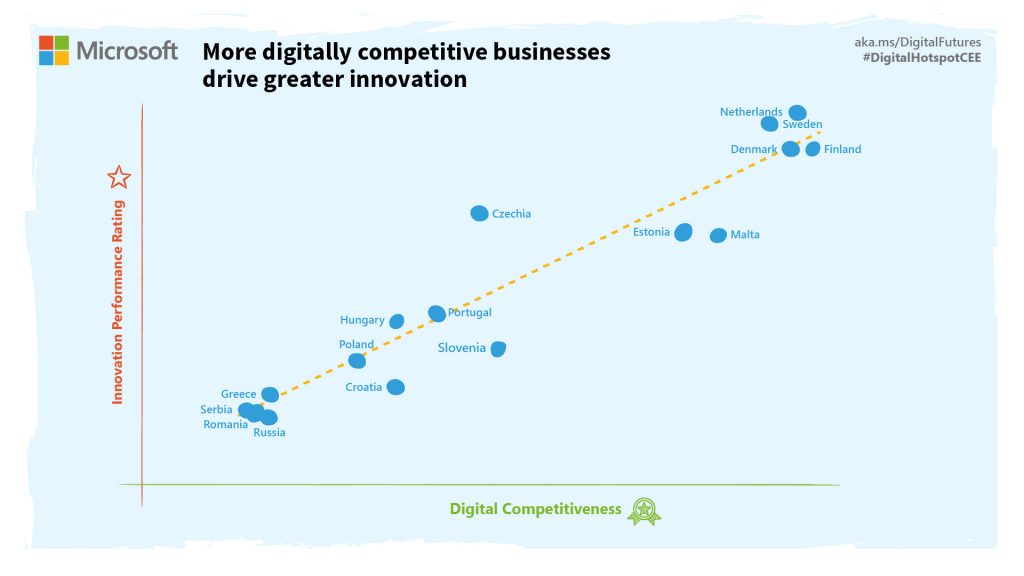
Learning from ‘digital frontrunners’ will help us grow business competitiveness and our quality-of-life
Our data-led exploration of digital development in Europe uncovered key actionable insights every leader can use to fuel digital progress for greater economic and societal benefit
Digital transformation is profoundly changing the way we work, live and do business. It’s re-shaping entire industries and the delivery of public services. But can we move faster and deliver greater positive outcomes for people, the economy and society?
The short answer is yes – evidenced by the acceleration we’ve seen over the past 20 months. But to increase – not just sustain – the pace of digital development, business and government leaders are hungry for actionable insights. What can we learn from more digitally advanced nations that will help everyone map the fastest journey possible to a greener, wealthier, more innovative and competitive future?
To explore this question, we analysed the digital journeys of 16 European countries – from those at earlier stages to recognized ‘front-runners’. Using over 1,000 data points from trusted public sources, we created the Digital Futures Index to map digital development and model its relationship with societal and economic outcomes. What did we find?
You can explore the interactive Index for yourself below – what will you discover?
Empower a nation of digital achievers
We all want more rewarding jobs, to be more prosperous and to build a greener, more sustainable future for ourselves, our families and communities. Becoming active, digitally-proficient citizens will help us achieve these goals:
- Digital skills: Countries where people have deeper levels of ‘everyday’ digital skills, and more actively use digital technology and services of various kinds, score more highly on key quality-of-life indicators: we’re more productive and earn more, it drives more innovation that helps the economy grow – creating new and better jobs, lowers air pollution and contributes to greener communities.
- Inclusive skills: Outcomes are even greater when skills are more inclusive – we see some of the strongest relationships to quality-of-life outcomes with higher levels of digital skills amongst women and people aged 45-64.
- Sustainable future: Digital skills and digital technology are driving positive environmental impact. We found 50+ correlations with sustainability outcomes, with the strongest being private and public spending on digital technology and the digital skills of the general population. Having more digitally proficient citizens plays an important role in us all having cleaner air to breath and a greener environment to live in.
- Digital services: Public interaction with government via digital technology and ease of setting up and running citizen-centric digital platforms also correlate to quality-of-life outcomes. It suggests that public sector digitization plays a key role in catalysing digital proficiency through encouraging use of digital services in the widest population, by everyone.
The bottom line? We all need to become lifelong learners, to develop and grow our digital skills. No matter our level of digital proficiency today, we can all achieve more – which drives better outcomes for all of us. Moreover, digitizing public services creates a virtuous cycle: the more digitally proficient and active people are, the more they benefit from the digital economy, which creates demand for more digital services, which enables people to do more – and so the circle goes.
Competitiveness is digital
Every business wants to innovate faster and be more productive so they can better compete and grow. Digitization can have a transformative impact, opening new doors for companies and creating opportunity for employees:
- Digital businesses are the engine of progress: Investment in digital infrastructure and technology and how businesses rank on ‘digital competitiveness’ have the strongest links with overall economic and societal outcomes.
- Technology foundations: Country-level investment (private and public sector) in ICT, Cloud, IoT, and AI has the strongest correlation with innovation overall. And businesses that spend more on digital technology and services, especially cloud computing, are more innovative and productive – twin priorities for every firm.
- IT workforce: But it’s not just tech that’s important. Higher levels of innovation and productivity correlate with higher levels of ICT specialists in the workforce – having skilled IT pros enables businesses to mainstream advanced digital technologies and maximise their impact.
- Digital-first leaders: Moreover, higher levels of digitally-skilled 45-64 year olds links to increased productivity and innovation. These ’50-somethings’ are more often in senior roles in business and can act as digital game-changers.
- Set innovation free: Innovation thrives when it’s not constrained to the office, as we saw with increased remote working during the pandemic. The flexibility in how teams connect and collaborate led to greater innovation, including more patents being registered, as well as enhancing productivity. Businesses can lock in these gains through permanently shifting to a hybrid working culture.
Bottom line? Investing in technology is a necessary start but not enough to be successful if firms don’t also prioritize digital skills, digital-first leadership and hybrid working culture. A lot has been said about the need to significantly upskill employees – including tech specialists. But a real game-changer is having digitally-savvy leaders who are attuned to getting the most strategic benefit from digital transformation. Our data inquiry shows that digital-first leadership is a significant competitive advantage – and those stuck in analogue risk being left behind. It also underscores that embracing hybrid working isn’t just a ‘nice-to-have’ or predominately about resilience. It’s about making the best of your talent and fuelling growth.
Make the shift to digital-first government
With public finances yet to recover from the impact of the pandemic, every decision to invest is being heavily scrutinized. Government leaders need to have confidence that where they choose to focus resources – including EU recovery funding – will deliver the best outcomes:
- Digital development is at the heart of everything that matters to people, businesses and communities: It is associated with higher productivity & averages salaries; greater sustainability and lower air pollution; better innovation performance ratings and more patents.
- It takes a well-organized village to innovate: Innovation doesn’t just happen through inspired individuals. We found that every category of digital development correlates to increased innovation. In other words, innovation needs a connected ecosystem and a holistic approach by policy-makers to intentionally cultivate it, encompassing business, the digital sector, digital infrastructure, start-ups, talent and the public sector (countries that have high levels of digitized public services see higher innovation and productivity).
- Digital government development: The ease at which new digital frontline services for citizens can be developed and delivered – based on a modern policy & regulatory landscape – is also closely tied with overall innovation levels.
The bottom line? Digitization is the foundation for everything that matters. Government policy and investment in digital technology and services is an integral part of catalysing innovation, stimulating growth or tackling societal challenges. In particular, there is increasing urgency to take action to meet environmental targets and accelerate the shift to a more sustainable economy. Digitization has a strong relationship with a country’s environmental performance and lower air pollution, and should be twinned with ‘green’ strategies as part of national recovery initiatives. The greatest impact will come from investing in both digital technology and skilling people.
Going digital for a better future
Everyone has a role to play. It’s not where a country, business or person is today on their digital journey which is most important – it’s the speed at which they progress. The Digital Futures Index was created to instigate debate amongst policy-makers, leaders in private and public organizations, entrepreneurs and innovators as well as the broader public as to how, together, we can realize our shared goals.
That matters to all of us, as it’s about our lives, our careers, our futures.
Methodology
Using trusted public data sets we created a data model to map digital development along a wide range of parameters. We also collected and modelled key economic and social benefit indicators, enabling us to do cross-correlations to understand the positive relationships that exist between the level of digital development and outcomes for countries, businesses and citizens.
In total, our model includes 55 individual data parameters. These are organized under categories and sub-categories to make it simple and logical to both model and navigate. Data sources were selected on the basis of geographic coverage, date of publishing and credibility.
Digital development categories:
- Digital Business
- Digital Infrastructure
- Digital Government & Public Sector
- Digital Sector
- Human Capital
Economic & societal gains categories:
- Economic Development
- Governance Efficiency
- Level of Innovation
- Sustainability Performance
Primary data sources include Eurostat, OECD, UN, WTO, Euromonitor, IMF, European Investment Bank, European Commission, European Environmental Agency and the World Bank. The appendix in the Index has further detail on the data, the taxonomy for the data model and a glossary of terms.
The Index includes data for the following Central & Eastern European countries, which represent a broad spectrum of digital development:
- Croatia
- Czech Republic
- Estonia
- Hungary
- Greece
- Malta
- Poland
- Romania
- Russia
- Serbia
- Slovenia
It also includes a select group of advanced ‘benchmark’ Western Europe countries. These were chosen on basis of being identified in various authoritative reports, including from McKinsey, as digital frontrunner nations.
- Denmark
- Finland
- Netherlands
- Sweden
Lastly, we included Portugal to provide an additional point of comparison as it is a fast-moving ‘digital riser’.

















